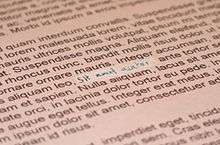Correction fluid

A correction fluid or white-out is an opaque, usually white fluid applied to paper to mask errors in text. Once dried, it can be written over. It is typically packaged in small bottles, and the lid has an attached brush (or a triangular piece of foam) which dips into the bottle. The brush is used to apply the fluid onto the paper.
Before the invention of word processors, correction fluid greatly facilitated the production of typewritten documents.
One of the first forms of correction fluid was invented in 1951 by the secretary Bette Nesmith Graham, founder of Liquid Paper.[1]
With the advent of coloured paper stocks for office/typing/photocopier use, correction fluid manufacturers began producing their product in various colours, particularly reds, blues and yellows, so that corrections made on these papers would be less visually invasive.
Thinner
Because it contains organic solvents (volatile organic compounds), unused correction fluid thickens over time as volatile solvents escape into the air. It can become too thick to use, and sometimes completely solidifies. Therefore, some manufacturers also sell bottles of solvent as "thinner", a few drops of which will return the correction fluid to its original liquid state.
Thinner originally contained toluene, which was banned due to its toxicity. Later, it contained 1,1,1-trichloroethane, a skin irritant now widely banned under the Montreal Protocol on Substances That Deplete the Ozone Layer, and then the slightly safer trichloroethylene. Thinners currently used with correction fluid include bromopropane.
To avoid the inconveniences of organic solvents (safety and availability), some brands of fluid are water-based. However, those have the disadvantages of a longer drying time, and incompatibility with some inks (which will soak through them).
Abuse as an inhalant
Organic solvents are psychoactive when sufficient amounts are inhaled. Such solvents are common inhalants for adolescents[2] due, in part, to the fact that they are inexpensive in comparison to other recreational drugs. Use of correction fluid as an inhalant can cause the heart to beat rapidly and irregularly, which can cause death. An unpleasant smell is added to some brands in order to deter abusers.[3] Companies have worked closely with authorities in order to ensure that all the warnings are duly mentioned on packaging (card and product labels) to inform parents and younger users of the risks associated with inhaling or drinking the fluid. India has imposed a ban on the retail sale of bottled nail polish remover and bottled correction fluid, but permits its sale in devices that provide a small amount of the chemical in a container that dispenses it in a controlled way. The manufacturer is required to affix a warning regarding the possible adverse effects on health if the material is inhaled.[4] Something to take into consideration is that enough of this fluid on the skin for a long enough time has possibilities of giving a chemical burn as well.
Notable brands
Correction fluid is commonly referred to by the leading brand names. These brands include:
- Liquid Paper
- Snopake
- White Away
- Wite-Out
- Tipp-Ex
- Twink
- Pentel correction pen.
- Edigs
- Kores
Generally, "Liquid Paper" and "Wite-Out" are used in the United States, Canada, Australia and Tajikistan, while "Tipp-Ex" is used in Europe. Twink is the leading brand, and colloquial term, for correction fluid in New Zealand. In the English-speaking Caribbean the term "White-paper paste" and "White-out" are used. In India the name "White Ink" is used by the student community.. In Latin America "Liquid Paper" (or just "Liquid") is also the colloquial term over the correct Spanish term, "corrector". In Thailand, the term "ลิควิด" (Liquid) has also become a commonly-used term over "น้ำยาลบคำผิด" (literally "correction fluid").
See also
References
| Wikimedia Commons has media related to Correction fluid. |
- ↑ "Liquid Paper - Bette Nesmith Graham Invented Liquid Paper". Inventors.about.com. 2012-04-09. Retrieved 2013-03-28.
- ↑ "Sniffing Correction Fluid Can Stop Your Heart (1991)". Profiles.nlm.nih.gov. 2010-06-03. Retrieved 2013-03-28.
- ↑ "AROUND THE NATION; Youths Urged To Avoid Inhaling Typing Fluid". New York Times. May 10, 1984.
- ↑ http://pib.nic.in/newsite/erelease.aspx?relid=89738